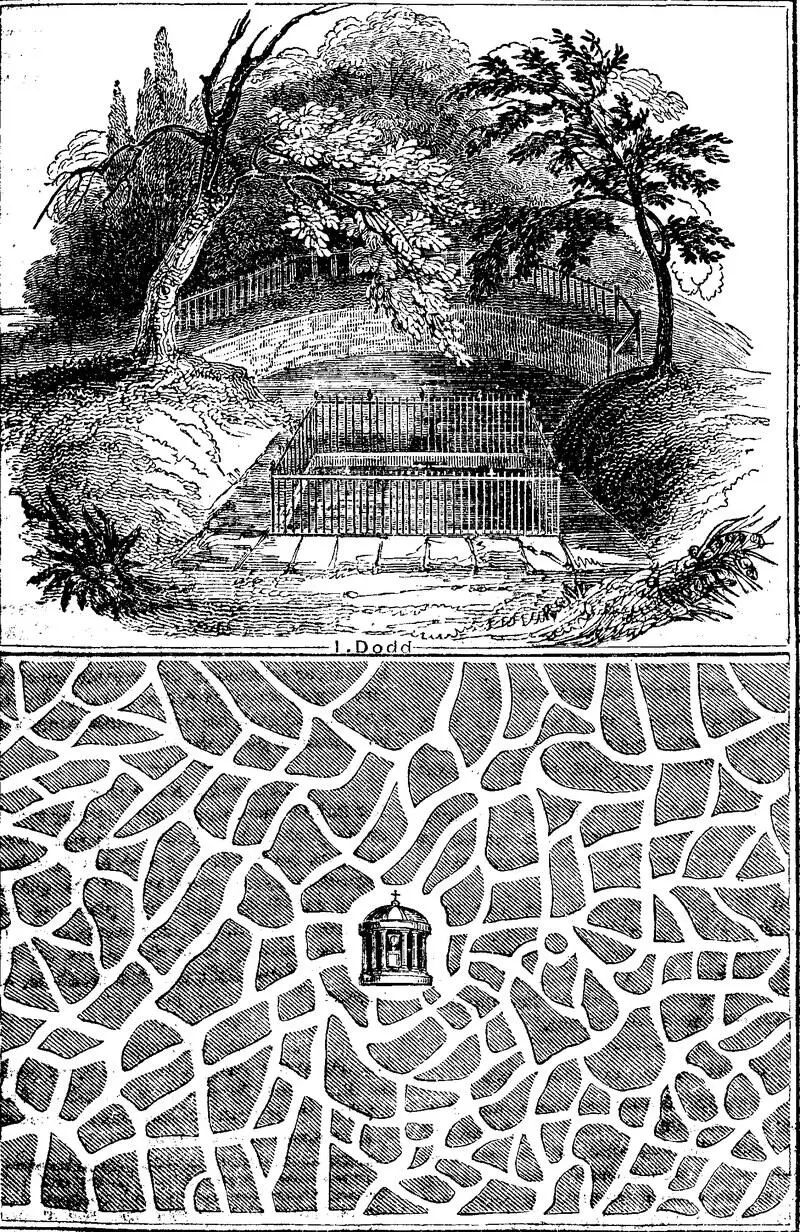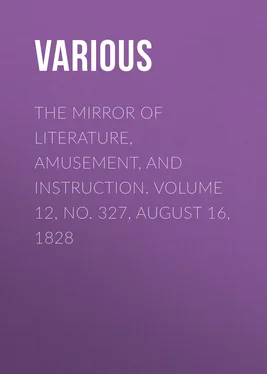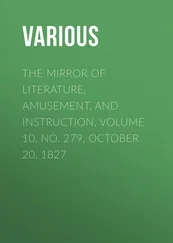Various - The Mirror of Literature, Amusement, and Instruction. Volume 12, No. 327, August 16, 1828
Здесь есть возможность читать онлайн «Various - The Mirror of Literature, Amusement, and Instruction. Volume 12, No. 327, August 16, 1828» — ознакомительный отрывок электронной книги совершенно бесплатно, а после прочтения отрывка купить полную версию. В некоторых случаях можно слушать аудио, скачать через торрент в формате fb2 и присутствует краткое содержание. Жанр: foreign_antique, periodic, Развлечения, foreign_edu, на английском языке. Описание произведения, (предисловие) а так же отзывы посетителей доступны на портале библиотеки ЛибКат.
- Название:The Mirror of Literature, Amusement, and Instruction. Volume 12, No. 327, August 16, 1828
- Автор:
- Жанр:
- Год:неизвестен
- ISBN:нет данных
- Рейтинг книги:3 / 5. Голосов: 1
-
Избранное:Добавить в избранное
- Отзывы:
-
Ваша оценка:
- 60
- 1
- 2
- 3
- 4
- 5
The Mirror of Literature, Amusement, and Instruction. Volume 12, No. 327, August 16, 1828: краткое содержание, описание и аннотация
Предлагаем к чтению аннотацию, описание, краткое содержание или предисловие (зависит от того, что написал сам автор книги «The Mirror of Literature, Amusement, and Instruction. Volume 12, No. 327, August 16, 1828»). Если вы не нашли необходимую информацию о книге — напишите в комментариях, мы постараемся отыскать её.
The Mirror of Literature, Amusement, and Instruction. Volume 12, No. 327, August 16, 1828 — читать онлайн ознакомительный отрывок
Ниже представлен текст книги, разбитый по страницам. Система сохранения места последней прочитанной страницы, позволяет с удобством читать онлайн бесплатно книгу «The Mirror of Literature, Amusement, and Instruction. Volume 12, No. 327, August 16, 1828», без необходимости каждый раз заново искать на чём Вы остановились. Поставьте закладку, и сможете в любой момент перейти на страницу, на которой закончили чтение.
Интервал:
Закладка:
Various
The Mirror of Literature, Amusement, and Instruction / Volume 12, No. 327, August 16, 1828
ROSAMOND'S WELL AND LABYRINTH

Rosamond's Well and Labyrinth at Woodstock.
For the originals of the annexed engravings we are indebted to the sketchbooks of two esteemed correspondents. 1 1 SAGITTARIUS—and T.W. of Hoxton.
The sites are so consecrated, or we should rather say perpetuated, in history, and the fates and fortunes of Rosamond Clifford are so familiar to our readers, that we shall add but few words on the locality of the Well and Bower. Their existence is thus attested by Drayton, the poet, in the reign of Queen Elizabeth:—"Rosamond's Labyrinth, whose ruins, together with her Well, being paved with square stones in the bottom, and also her Tower, from which the Labyrinth did run, are yet remaining, being vaults arched and walled with stone and brick, almost inextricably wound within one another, by which, if at any time her lodging were laid about by the queen, she might easily avoid peril imminent, and, if need be, by secret issues, take the air abroad, many furlongs about Woodstock, in Oxfordfordshire."
Sir Walter Scott (of whom, as of Goldsmith, it may hereafter be said, he "left no species of writing untouched or unadorned by his pen") has resuscitated the interest attached to this spot, in his masterly novel of Woodstock . 2 2 For an abstract of "Woodstock," an engraving, and much valuable information respecting the palace, see our vol. vii. pp. 289—316—322—327—338, &c.
It is here that the beautiful Alice meets the facetious Charles in his disguise of an old woman; and on the bank over the Well is the spot where tradition relates fair Rosamond yielded to the menaces of Eleanor. Our correspondent, T.W. , jocosely observes, that he sends us the Labyrinth "without the silken cord which guided the cruel Eleanor to her rival, in the hope that the ingenuity of the reader will be sufficient to serve him in its stead. Observe," continues he, "the maze is entered at one of the side gates, and the bower must be reached without any of the barriers (—) being passed over—that is, by an uninterrupted pathway." 3 3 As there is a vulgar error on Rosamond's being buried in the labyrinth, we subjoin the following by another correspondent. Many readers of the MIRROR, perhaps, have hitherto been only acquainted with the fictitious part of Fair Rosamond's history. The few subjoined facts, relative to the eventful life of that lady, may be implicitly relied on, as they are very carefully gleaned from the most authenticated sources . The first mistress to king Henry II. was Rosamond, daughter of Walter Clifford, Baron of Hereford. She was esteemed the greatest beauty in England, and her intrigue with Henry was most probably began when he was not much above sixteen years of age. Very soon after his amorous acquaintance with this lady, the state of political affairs in England required his absence, and he did not again return to this country until the year 1153; so that there must have been a lapse of nearly six years from the period of his first intimacy with Rosamond, to the renewal of that intimacy at his return. About the year 1157, king Henry took extraordinary precautions to conceal his intrigue from the knowledge of queen Eleanor, a woman, of wonderful spirit and penetration, to whom he had been espoused at the period of his accession to the throne, in 1155. This circumstance has given rise to the romantic tradition of his forming a sort of labyrinth at Woodstock Palace, for the purpose of concealing his fond mistress from the vengeance of Eleanor; but the story of her being murdered in that palace by the queen is perfectly false, for it is sufficiently evident that she retired to the nunnery of Godstow, where she ended her days in peace, though in what year it is difficult to decide. After Rosamond's decease, the king bestowed large revenues on the convent, in return for which, he required that lamps should be kept continually burning about the lady's remains, which were interred near the high altar, in a tomb covered with silk. We may naturally conclude from these circumstances, that, as long as the connexion between king Henry and Rosamond continued, the former had no other object in his affections; yet we are informed by a writer of Thomas à Becket's life, that there lived a remarkably handsome girl, at Stafford, with whom king Henry was said to cohabit. However, observes the same writer, Rosamond might have been dead before the second intrigue was commenced. G.W.N.
The bower consists of fine tall trees, whose branches hang entwined over the front of the well. The spring is contained in a large basin, formed by a plain stone wall, which serves as a facing and support to the bank; the water flows from hence through a hole of about five inches in diameter, and is conveyed by a channel under the pavement into another basin of considerable dimensions, fenced with an iron railing. Hence it again escapes by means of a grating into the beautiful lake of Woodstock Park, or, as it is more modernly termed, Blenheim.
In these days of "hobgoblin lore," it may not be incurious to add, that Woodstock is distinguished in Dr. Plot's History of Oxfordshire (the title of which is well known to all readers of the marvellous) as the scene of a series of hoax and disturbance played off upon the commissioners of the Long Parliament, who were sent down to dispark and destroy Woodstock, after the death of Charles I.; and Sir Walter Scott thinks it "highly probable" that this "piece of phantasmagoria was conducted by means of the secret passages and recesses in the Labyrinth of Rosamond"—it must be admitted, a very convenient scene for such a farce. Sir Walter says, "I have not the book at hand"—neither have we; but we may probably allude to this curious affair on some future occasion. In the meantime, if our present reference should kindle the curiosity of the reader, and he may not be disposed to await our time, we beg to recommend him to Glanville's well-known work on witchcraft, which not only contains Dr. Plot's narrative of the Woodstock disturbances, but a multitude of argument for all who are sceptical of this and similar mysteries. This is an age of inquiry, and we do not see why such follies should be left unturned—from Priam's shade to the murderous dreams and omens of our own times.
THE "NAPOLEON" CHILD
On Friday the 8th inst. we paid a visit to the Bazaar in Oxford-street, to witness this extraordinary sport of Nature, about which the French and English newspapers have lately been so communicative.
The child is an engaging little girl, about three years old. The colour of her eyes is pale blue, and on the iris, or circle round their pupils, the inscriptions on
Left Eye .
NAPOLEON
EMPEREUR.
Right Eye .
EMPEREUR.
NAPOLEON.
may be traced in the above sized letters, although all the letters are not equally visible, the commencement "NAP" and "EMP" being the most distinct. The colour of the letters is almost white, and at first sight of the child they appear like rays , which make the eyes appear vivacious and sparkling. The accuracy of the inscriptions is much assisted by the stillness of the eye, on its being directed upwards, as to an object on the ceiling of the room, &c.; and with this aid the several letters may be traced with the naked eye.
This effect is accounted for by the child's mother earnestly looking at a franc-piece of Napoleon's, which was given to her by her brother previous to a long absence; and this operating during her pregnancy, has produced the appearance in question. It was visible at the child's birth, and has increased with her growth. She has been seen by Sir Astley Cooper and other leading members of the profession, and probably before our Number is published, she will have been shown to the King. She is an interesting little creature, prattles playfully, and will doubtless receive the caresses of thousands of visitors.
Читать дальшеИнтервал:
Закладка:
Похожие книги на «The Mirror of Literature, Amusement, and Instruction. Volume 12, No. 327, August 16, 1828»
Представляем Вашему вниманию похожие книги на «The Mirror of Literature, Amusement, and Instruction. Volume 12, No. 327, August 16, 1828» списком для выбора. Мы отобрали схожую по названию и смыслу литературу в надежде предоставить читателям больше вариантов отыскать новые, интересные, ещё непрочитанные произведения.
Обсуждение, отзывы о книге «The Mirror of Literature, Amusement, and Instruction. Volume 12, No. 327, August 16, 1828» и просто собственные мнения читателей. Оставьте ваши комментарии, напишите, что Вы думаете о произведении, его смысле или главных героях. Укажите что конкретно понравилось, а что нет, и почему Вы так считаете.












